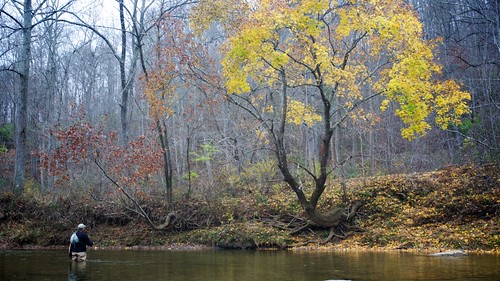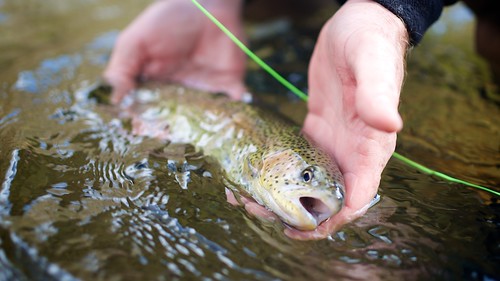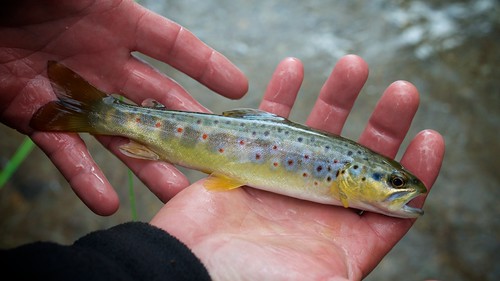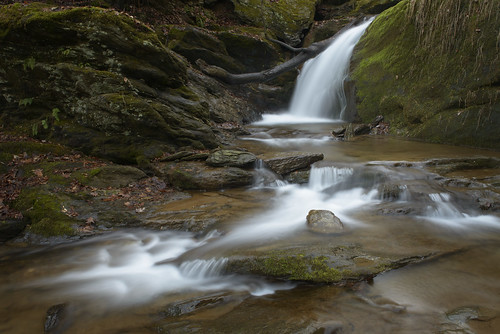Fall fly fishing in Pennsylvania offers anglers an awesome opportunity to enjoy cool, colorful days on some spectacular streams. Anglers will appreciate the solitude of fall fishing while others are busy with different fall activities. There are plenty of streams across the state with trout and hatches to keep you busy on familiar waters and even going after some streams you’ve been thinking about.
Just like in the spring, you’re looking for trout and good water. There are plenty of streams that have naturally reproducing trout as well as stocked waters by the Pennsylvania Fish and Boat Commission (PFBC). However, the PFBC only provides very limited stocking on select streams during the fall, which starts at the end of September through the beginning of October.
Hatches
As the weather begins to change, so does the entomology or insect life in the stream. Activity will differ from region to region, stream size, summer water temperatures, and geology. The fall provides a more limited selection of insects, and often, anglers enjoy bringing a more modest selection of flies and imitations. Some of the more popular collections include Slate Drakes, BWOs, Caddis, terrestrials and egg patterns. Typical nymphs and streamers are always part of the mix.
Where to Fly Fish?
Stocked streams and Special Regulation Projects
About 40 streams are stocked after the start of fall by the PFBC. The number of trout is not close to the spring stockings, but offer increased angling opportunity to some of the more popular Special Regulation streams across the state like First Fork Sinnemahoning Creek, Lackawaxen River, Little Pine Creek, Ridley Creek, and Laurel Hill Creek, to name a few. The full list of fall stocked lakes and streams can be found at the PFBC site here. Some private clubs and Co-operative Nurseries also provide some stockings beside the PFBC, but those details are not publicly released.
Class A Trout Streams
Class A Wild Trout Streams are designated by the PFBC as: “Streams that support a population of wild (natural reproduction) trout of sufficient size and abundance to support a long-term and rewarding sport fishery. The Commission does not stock these stream sections.”
There are hundreds of these streams across the state. Some of the more popular streams are Penns Creek, Little Juniata, and Spring Creek. There are hundreds of streams across the state in this category, and a full PDF listing can be found here. Not all Class A stream sections are on public land so always ask permission from landowners when approaching Class As or other wild trout streams.
The wild trout in these streams behave and act differently than their pellet raised brothers. You’ll find these trout having lived a season or two and are well adjusted to their environment. They have survived the heat of the summer, floods, predators and have seen hundreds of anglers casting all kinds fly past them. Anglers who know the waters, conditions, and entomology of the fall will be rewarded for their knowledge with some fun but challenging trout.
Wilderness Trout Streams
“Wilderness Trout Streams are a sub-group of wild trout streams; some Wilderness Trout Streams also have a Class A designation based on meeting a minimum biomass threshold. Under 58 Pa. Code §57.4, it is the Commission’s policy to manage wilderness trout streams where stream remoteness and populations of wild trout combine to offer sport-fishing opportunities for anglers in a wilderness setting.” – PFBC. Often these remote wild trout stream areas share use with Hunters so always carry some blaze orange with you to help you to be recognized by hunters.
These streams offer anglers a unique experience of often remote and out of the way streams with wild trout. Hopefully, anglers who make their way to these streams are rewarded with native brook trout in some great settings. These are often small feeder streams and those no-name streams you roll past getting to bigger, more popular stocked waters. These streams should be treated with great respect due to their fragile and unique environments. However, these streams are not all in the remote mountains of the state, but can often be found just around the corner of your home if you search a little.
Anglers with a sense of adventure, stealth, and respect can have a lot of fun with little gems scattered throughout the state. Generally, we ask that you not even post a stream report for these special streams to keep the traffic and adventure optimal.
For more detailed designations on all the wild trout waters from the PFBC, anglers will enjoy the PDF publication - Pennsylvania’s Wild Trout Streams.
Watch Out for the Redds
Reproduction plays an important part of the trout lifecycle during the fall months for both brook and brown trout. Brook trout, native to the Eastern US, usually spawn during late September through October. Brown trout typically spawn in October through late November. However, each stream is very different when this actually occurs.
During the spawn, the coloring on the trout will intensify, especially in the males. Females will create gravel beds called "reds" for the dropped eggs to be fertilized. It is very important to avoid fishing these sections on streams when you see redds and be careful not to kick them up when wading. It is probably best even to leave trout to overtop redds alone and give them a chance to protect the eggs.
Enjoy your fall fly fishing and add your stream report to the forum to share with others when you return.
Just like in the spring, you’re looking for trout and good water. There are plenty of streams that have naturally reproducing trout as well as stocked waters by the Pennsylvania Fish and Boat Commission (PFBC). However, the PFBC only provides very limited stocking on select streams during the fall, which starts at the end of September through the beginning of October.
Hatches
As the weather begins to change, so does the entomology or insect life in the stream. Activity will differ from region to region, stream size, summer water temperatures, and geology. The fall provides a more limited selection of insects, and often, anglers enjoy bringing a more modest selection of flies and imitations. Some of the more popular collections include Slate Drakes, BWOs, Caddis, terrestrials and egg patterns. Typical nymphs and streamers are always part of the mix.
Where to Fly Fish?
Stocked streams and Special Regulation Projects
About 40 streams are stocked after the start of fall by the PFBC. The number of trout is not close to the spring stockings, but offer increased angling opportunity to some of the more popular Special Regulation streams across the state like First Fork Sinnemahoning Creek, Lackawaxen River, Little Pine Creek, Ridley Creek, and Laurel Hill Creek, to name a few. The full list of fall stocked lakes and streams can be found at the PFBC site here. Some private clubs and Co-operative Nurseries also provide some stockings beside the PFBC, but those details are not publicly released.
Class A Trout Streams
Class A Wild Trout Streams are designated by the PFBC as: “Streams that support a population of wild (natural reproduction) trout of sufficient size and abundance to support a long-term and rewarding sport fishery. The Commission does not stock these stream sections.”
There are hundreds of these streams across the state. Some of the more popular streams are Penns Creek, Little Juniata, and Spring Creek. There are hundreds of streams across the state in this category, and a full PDF listing can be found here. Not all Class A stream sections are on public land so always ask permission from landowners when approaching Class As or other wild trout streams.
The wild trout in these streams behave and act differently than their pellet raised brothers. You’ll find these trout having lived a season or two and are well adjusted to their environment. They have survived the heat of the summer, floods, predators and have seen hundreds of anglers casting all kinds fly past them. Anglers who know the waters, conditions, and entomology of the fall will be rewarded for their knowledge with some fun but challenging trout.
Wilderness Trout Streams
“Wilderness Trout Streams are a sub-group of wild trout streams; some Wilderness Trout Streams also have a Class A designation based on meeting a minimum biomass threshold. Under 58 Pa. Code §57.4, it is the Commission’s policy to manage wilderness trout streams where stream remoteness and populations of wild trout combine to offer sport-fishing opportunities for anglers in a wilderness setting.” – PFBC. Often these remote wild trout stream areas share use with Hunters so always carry some blaze orange with you to help you to be recognized by hunters.
These streams offer anglers a unique experience of often remote and out of the way streams with wild trout. Hopefully, anglers who make their way to these streams are rewarded with native brook trout in some great settings. These are often small feeder streams and those no-name streams you roll past getting to bigger, more popular stocked waters. These streams should be treated with great respect due to their fragile and unique environments. However, these streams are not all in the remote mountains of the state, but can often be found just around the corner of your home if you search a little.
Anglers with a sense of adventure, stealth, and respect can have a lot of fun with little gems scattered throughout the state. Generally, we ask that you not even post a stream report for these special streams to keep the traffic and adventure optimal.
For more detailed designations on all the wild trout waters from the PFBC, anglers will enjoy the PDF publication - Pennsylvania’s Wild Trout Streams.
Watch Out for the Redds
Reproduction plays an important part of the trout lifecycle during the fall months for both brook and brown trout. Brook trout, native to the Eastern US, usually spawn during late September through October. Brown trout typically spawn in October through late November. However, each stream is very different when this actually occurs.
During the spawn, the coloring on the trout will intensify, especially in the males. Females will create gravel beds called "reds" for the dropped eggs to be fertilized. It is very important to avoid fishing these sections on streams when you see redds and be careful not to kick them up when wading. It is probably best even to leave trout to overtop redds alone and give them a chance to protect the eggs.
Enjoy your fall fly fishing and add your stream report to the forum to share with others when you return.







